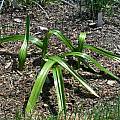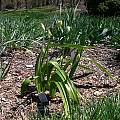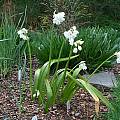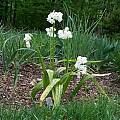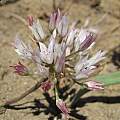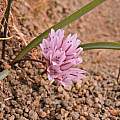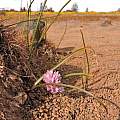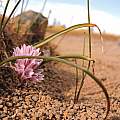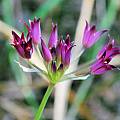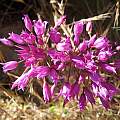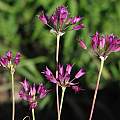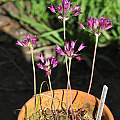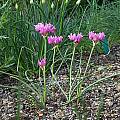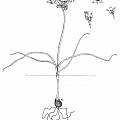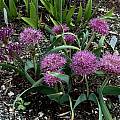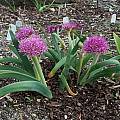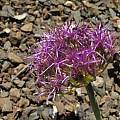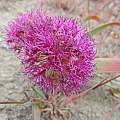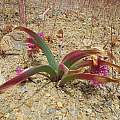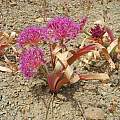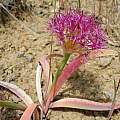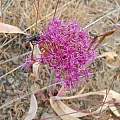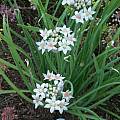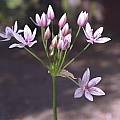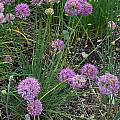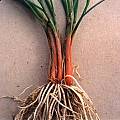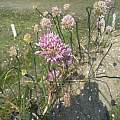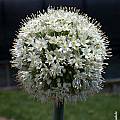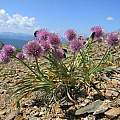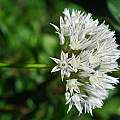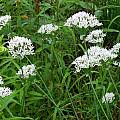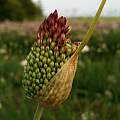This page compiles all the information and photos of the Allium taxa, cultivars, and hybrids we currently have on the PBS wiki. The Allium index gives information about the genus and includes tables of species and hybrids and cultivars.
Page 1: A. Globemaster... Page 2: A. atropurpureum... Page 3: A. carmeli... Page 4: A. decipiens... Page 5: A. guttatum... Page 6: A. karataviense... Page 7: A. membranaceum... Page 9: A. regelii... Page 10: A. serra... Page 11: A. tardiflorum... Page 12: A. vineale...
Allium paradoxum (M.Bieb.) G.Don ssp. normale Stearn - From Iran, this is the non-bulbiliferous form of a normally bulbiliferous and weedy species. Growers in England complain that even the subspecies is a weed and warn against growing it. Here in a colder climate (northern New England, USA) it is barely able to survive and frequently gets damaged by late hard freezes. Absolutely one of my favorites, and an interesting plant on all accounts. The shiny green leaves have a central raised vein on the upper surface and give the distinct impression that the leaves are upside-down. The leaves recline and conceal the emerging buds initially. If the frost doesn't get them, the decorative pendant bells are large and pristine white, reminiscent of Leucojum. Flowers in early April. Photos by Mark McDonough.
Allium parryi S.Watson (syn. Allium fimbriatum var. parryi (S.Watson)Traub & Ownbey), grows on sandy or clay soils in the southern Sierra Nevada and southern California mountains, south to northern Baja California. It is white with pink midveins, fading to red as it ages. It has smooth ovary crests. Photo taken in San Diego County by Jim Duggan.
Allium parvum Kellogg is known as the small or dwarf onion, as it rarely grows taller than five inches. The inflorescence is borne on a short scape close to the ground, with less than 30 pointed pinkish florets with dark mid veins and yellow pollen. The leaves are keeled, somewhat sickle shaped, growing longer than the scape. It is native to Western North America from Northern California, north to Oregon, east to Nevada and possibly Utah. It has also been reported to be found in the two most southwestern counties of Montana. It can be found growing in rocky clay soils, talus, from mid to high elevations. It is one of the species to inhabit the plateaus of Table Rocks in Jackson County, Oregon. Photos below by Travis Owen from Upper Table Rock in Oregon in March of 2015.
Allium peninsulare Lemmon ex Greene is a species from California, southern Oregon and Baja California with wine-red to dark rose-purple flowers in a loose umbel. Photos 1-2 were taken by Mary Sue Ittner. Photo 3 was from San Diego County taken by Jim Duggan. Photos 4-5 were taken by Nhu Nguyen of some bulbs growing in a 4" terracotta pot. This species does not need a lot of room to do well.
Allium perdulce S.V.Fraser - a gem of a species, from the American plains and prairies, and extending southwards into Texas. The flowers are intensely fragrant like cloves (dianthus), so sweet and spicy that it'll force you onto your belly to take frequent whiffs. It's one of the earliest blooming species, with rich pink, flared urn-shaped flowers on mere 4"-6" (10-15 cm) stems. It's exceedingly slow to increase for me (usually goes the other way!) and never sets viable seed in my garden. To be coveted. Photos by Mark McDonough and a line drawing as well.
Allium platycaule S,Watson - is a western American allium from California, Oregon & Nevada. They occur on rocky or sandy slopes. The foliage is broad, gray, and sickle-shaped and arching sideways (falcate), and the large fuzzy globes of pink flowers only a few inches above the ground create a memorable sight. In the first photo, two bloom heads of the darker red-purple Allium falcifolium Hook. & Arn. can be seen. First two photos by Mark McDonough, last photo by Nhu Nguyen at the UC Botanical Garden.
Photos taken in Plumas County, California by Mary Sue Ittner.
Allium plummerae S.Watson - one of my absolute favorites onions. It has a very limited range in Arizona and New Mexico, found at high elevation in marshes and alongside streams. Accordingly it prefers good garden soil and adequate irrigation. Upright tufts of strongly keeled (almost three-sided) grayish foliage, and showy flat clusters of wide-open upright stars. The flowers are pure white, with creamy yellow ovaries that age a tawny orangish color. Very reliable, non-invasive, clump-forming species, blooming in July-August. Photo by Mark McDonough.
Allium praecox Brandegee is found in shaded grassy slopes in southwestern California. Photo by Mary Sue Ittner
Allium przewalskianum Regel is a delightful small species from Central Asia to China, with very fine terete foliage, good-sized balls of rose-purple flowers, and distinctive fibrous orange-colored bulb bases. The second photo is a clear close-up up the cinnamon orange bulb bases and white roots. Photos by Mark McDonough.
Allium psebaicum Mikheev is a relatively newly described species mainly from Russia. The species was described in 2004 by A. D. Mikheev. Its distribution is suggested as spanning the North Caucasus, Caucasus, and into temperate Asia. Photo by Wietse Mellema.
Allium pskemense B.Fedtsch. is from Central Asia where it grows in stony places. This white flowered Allium named for the Pskem River blooms in late summer. Photo by John Lonsdale.
Allium pumilum Vved. is a rhizomatous alpine species native to the Mongolian Altai region in Central Asia. The plants grow at an altitude of around 2800 m in dry tundras and in alpine grasslands in the upper part of alpine belt. It is very similar to Allium amphibolum Lebeb., but differs in having curved instead of straight leaves. Photo by Andrey Dedov in the Altai Mountains.
Allium pyrenaicum Costa & Vayr. is a rare and endangered species endemic to Spain (Pyrenees). It is tall with a slender stem to about 1 m, growing in gorges mostly in cool conditions. Photo taken in its habitat by Oron Peri.
Allium ramosum L. is an early summer blooming species that is unnecessarily confused with Allium tuberosum Rottler & Spreng.. Flowering in June, stems can reach 3' (90 cm), with ample heads of nice white flowers, each tepal touched with a fine red nerves on the outside. This species has not been weedy nor aggressive like A. tuberosum. Photo by Mark McDonough.
Allium regelianum A.K.Becker (syn. Allium scythicum Zoz, Allium ampeloprasum var. regelianum (A.K.Baker)Nyman), is a rare Russian endemic that grows in semi-desert and grasslands where it dries out in summer. The plant grows to roughly 30-60 cm high with 3-4 narrow semi-cylindrical leaves. The species tolerates a range of habitats and soil types, even saline soils. It flowers around the end of June to July. Other onions in the region are Allium sphaerocephalon L., Allium lineare L., Allium flavescens Besser and Allium flavum subsp. tauricum (Besser ex Rchb.)K.Richt. The plant was first collected by botanist Alexander Becker (1818-1901) in a neighborhood of what is now Volgograd (formerly Krasnoarmeosk), Russia. The species was first described in a flora in the 1929 (Flora Jugo-Vostoka Evropeiskoi chasti SSSR 3:355-6). It was named after E.L. Regel, a Director of the St Petersburg Botanical Garden. Botanic Gardens Conservation International (BGCI) published an informative article on the species titled Allium regelianum A. Beck. - a Rare Russian Endemic. Photo by Wietse Mellema.
Page 1: A. Globemaster... Page 2: A. atropurpureum... Page 3: A. carmeli... Page 4: A. decipiens... Page 5: A. guttatum... Page 6: A. karataviense... Page 7: A. membranaceum... Page 9: A. regelii... Page 10: A. serra... Page 11: A. tardiflorum... Page 12: A. vineale...
Allium index - Allium flavum Relatives - American alliums A-F - American alliums G-Z - Big Ball alliums - Blue alliums - Chives - Domed alliums - Drumstick alliums - Rhizomatous alliums
